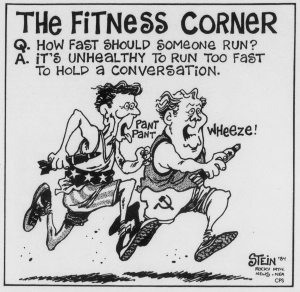Primary Source Set
Analyzing Political Cartoons
One of the ways that newspaper publishers express their views is through political cartoons. This editorial form became popular over the 20th century for the way it can quickly and forcefully deliver a viewpoint to its audience—particularly in decades when not all adults could read. This primary source set uses examples of political cartoons from school and community newspapers to show how the form has evolved over the last 100 years.
Proceed with caution and care through these materials as the content may be disturbing or difficult to review. Please read DigitalNC’s Harmful Content statement for further guidance.
Time Period
20th Century
Grade Level
9 – 12
The Guilfordian (Greensboro, N.C.), September 12, 1984
This cartoon was published in 1984, which was during a period of tension between the United States and the Soviet Union (a federation of countries including modern-day Russia, Ukraine, Kazakhstan, Belarus, and others). This tension was part of the end of the Cold War, an extended conflict between these two world powers and their allies to gain global influence. A major part of the Cold War was the arms race, where both sides endeavored to create and stockpile more powerful nuclear weapons than their rival.
Near the end of the Cold War, there was public pressure on world leaders to engage in diplomacy and eliminate the threat of nuclear warfare. Readers of The Guilfordian, the student newspaper at Guilford College in Greensboro, N.C., would have recognized the two people in this cartoon as U.S President Ronald Reagan (left) and Konstantin Chernenko, the leader of the Soviet Union (right). This cartoon was created by Ed Stein, a famous cartoonist for The Rocky Mountain News in Denver, Colorado.
Contributed to DigitalNC by Guilford College
Greensboro, N.C. (Guilford County)
Background
Many newspapers in the 20th and 21st centuries include editorial sections designed to make arguments or give opinions about topics in the news. One way for newspaper editors to present an opinion is through political cartoons. While these cartoons can be funny and entertaining, their primary purpose is to quickly make an argument about a political or social issue. Political cartoons can be found in all kinds of newspapers published in many different countries and can be used to address any issue that the audience of the newspaper recognizes. Many times, the artists address polarizing issues with cartoons or push the boundaries in an effort to evoke a reaction from readers.
Political cartoons often use some of the same rhetorical devices as written articles, including irony, symbolism, and analogy. Cartoons also have their own rhetorical devices, such as exaggerating characteristics of a particular person and labeling things to tell you what they represent. Sometimes, the meaning of the cartoon is made clear through a short title or caption. Additionally, understanding political cartoons usually requires knowing their contexts. Many of them contain representations of famous people or references to historical events. It may also help to know the intended audience of the newspaper.
Note: Some political cartoons depict stereotypes that may be uncomfortable to see. While the examples in this set avoid offensive imagery as much as possible, other pages of these newspapers may include it.
Discussion Questions
What do you see in this cartoon? Who are the characters? What are they doing?
What rhetorical devices is this cartoonist using? What elements are exaggerated or humorous?
What is the argument the cartoon is making? How do you know?
What does this cartoon tell you about this newspaper? Who is their primary audience? What viewpoints do they want to convey?
Do you find the cartoon’s point persuasive? Why or why not?
This primary source set was compiled by Sophie Hollis.
Updated January 2025
